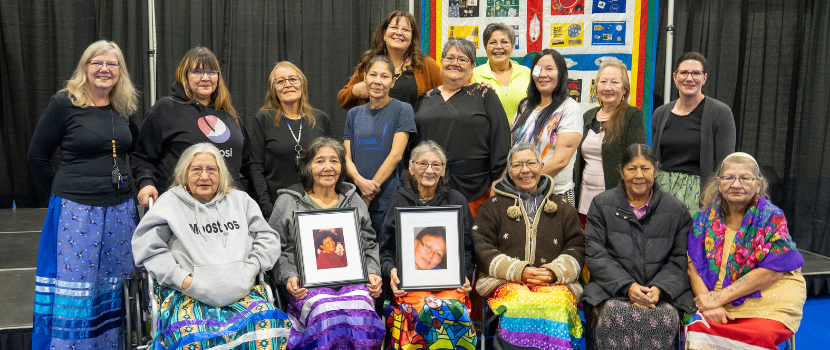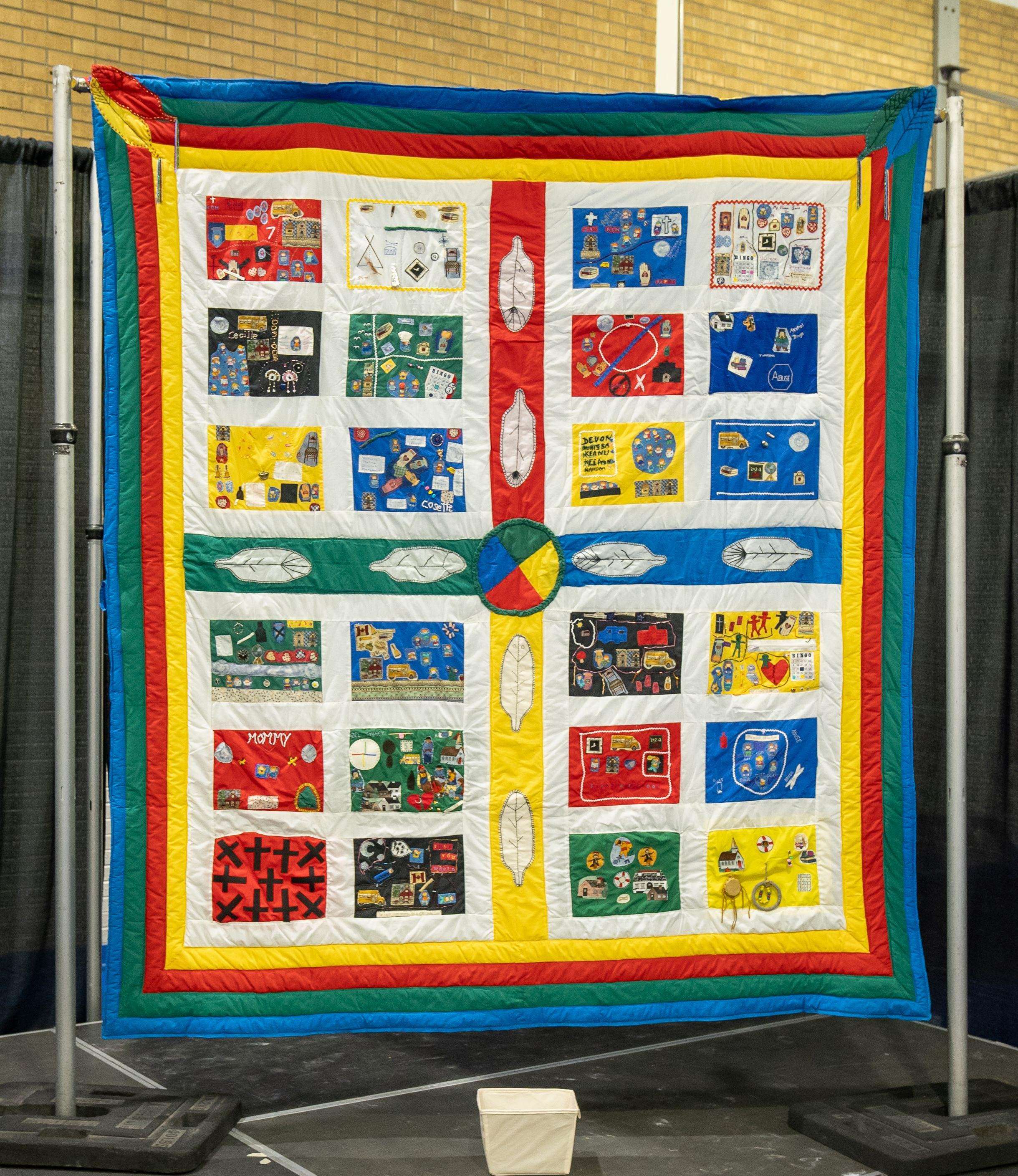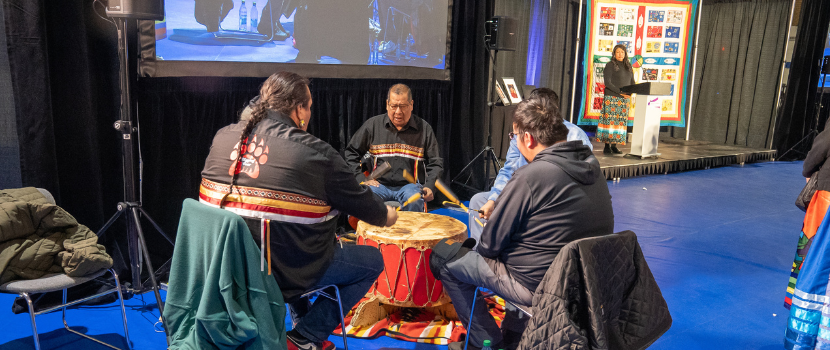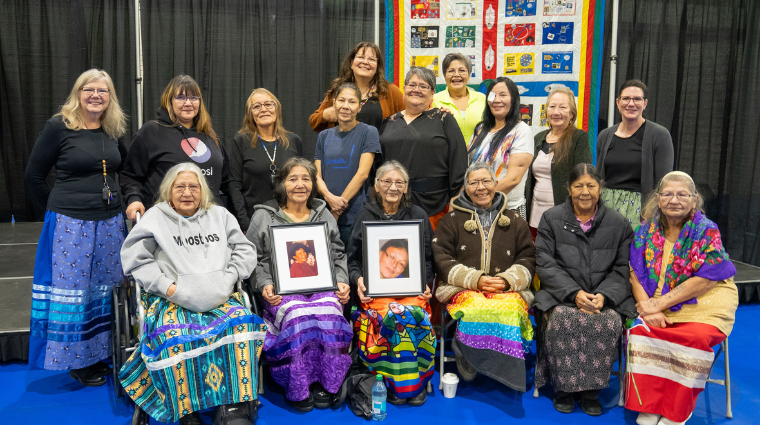
Saskatchewan Polytechnic is now the keeper of the Talking Quilt, a cherished cultural artifact created by the women of James Smith Cree Nation. The women gathered to sew quilt squares while sharing stories of hardships, including residential school experiences and abuse they have experienced over the course of their lives.
Founder Ruby Head started working on the quilt in 2000. Each square of the quilt tells a unique story, highlighting matriarchal journeys, truths and the healing within families. The quilt became known as the Talking Quilt, since the women shared their experiences while sewing squares together.

Elder Sandra Head shared the story of the Talking Quilt with Eileen Zaba, Sask Polytech Psychiatric Nursing faculty, and Lindsey Boechler, Sask Polytech Centre for Health Research, Innovation and Scholarship (CHRIS) researcher, while they were working with the community on an applied research project. On February 6, 2025, transfer of care for the Talking Quilt was passed from the women of James Smith Cree Nation to Sask Polytech.
“I’m happy the blanket is in a safe place,” shares Elder Sandra. “With the quilt, it was difficult at times, we would break down. It did help us in the healing process, because we learned to talk about what happened to us and put it to rest. When we worked on the quilt it brought out a lot of feelings for us. We got to understand the women, why they were the way they were, because of their experiences in residential school.”
“It is a great honour for Sask Polytech to be the keeper of the Talking Quilt at our Saskatoon campus on Treaty 6 Territory,” says Dr. Larry Rosia, Sask Polytech president and CEO. “By honouring the wishes of the women from the James Smith Cree Nation and preserving and displaying the quilt at Sask Polytech, this project enhances cultural understanding among our students, faculty, staff and public who visit Saskatoon campus. Thank you to the women of James Smith Cree Nation for trusting Sask Polytech to be the keeper of this cultural heirloom.”
During the ceremony at Saskatoon campus, the women who created the quilt entered the gym with the Talking Quilt while attendees lined the walkway, offering tobacco blessings. The James Smith Cree Nation elders and women then passed the quilt to representatives from Sask Polytech for safekeeping and display.
"The Talking Quilt was previously cared for by Elder Sandra," says Zaba. "She asked me to help her find a new keeper for the quilt as she did not want its history to be lost. After much discussion, we collaboratively decided that Sask Polytech, with its ongoing dedication to indigenization and reconciliation, is well positioned to serve as the keeper of the quilt."
In addition to displaying the Talking Quilt, Sask Polytech has interviewed and recorded the oral histories of the James Smith Cree Nation women who contributed to the quilt who are still alive, including Joan Daniels, Elder Sandra Head, Elder Cecile Moostoss, Cosette Moostoos, Tena Moostoos and Sharon Starblanket. These interviews are available at saskpolytech.ca/talkingquilt serving as an oral history to accompany the Talking Quilt. Other women who contributed to the quilt include Gina Head, Elder Arlene Moostoos, Brandi Sanderson, Elder Darlene Sanderson and Rhonda Sanderson. Women who contributed to the quilt but are no long with us include Ruby Head, Albertine Moostoos, and Sophia (Tarry) Whitehead.
By displaying the Talking Quilt and sharing the James Smith Cree women’s oral history, this project helps educate students, employees and leadership about Indigenous experiences and resilience. It also supports several Truth and Reconciliation Commission of Canada’s Calls to Action (CTA) including CTA 62 which focuses on incorporating Indigenous history, knowledge and perspectives into post-secondary education.
"This was one of the most profound and impactful ceremonies I’ve ever had the privilege to be part of," says Boechler. "These women are important matriarchs who shared hard truths while working on the quilt together. This event honoured these women and their important healing journeys."
Zaba and Boechler met Elder Sandra during an applied research project aimed at addressing the needs of rural and remote Indigenous communities in times of crisis. Their ongoing project focuses on developing a community crisis response framework in collaboration with Indigenous communities, emphasizing data collection and analysis to improve emergency responses.


The Talking Quilt initiative was funded in part by the Saskatchewan Health Research Foundation’s Truth and Action Fund and CHRIS. CHRIS supports faculty and students in the Sask Polytech School of Education and Community Services, School of Health Sciences and Leslie and Irene Dubé School of Nursing in achieving their scholarly development research goals and aspirations. A heartfelt thank you to Sask Polytech’s Media Production team for recording the oral histories of some of the women who contributed to the Talking Quilt.
Hear the oral history of the Talking Quilt at saskpolytech.ca/talkingquilt.
Saskatchewan Polytechnic is signatory to the SDG Accord. Sustainable Development Goal alignment is one of the ways Sask Polytech is leading the rise of polytechnic education.


